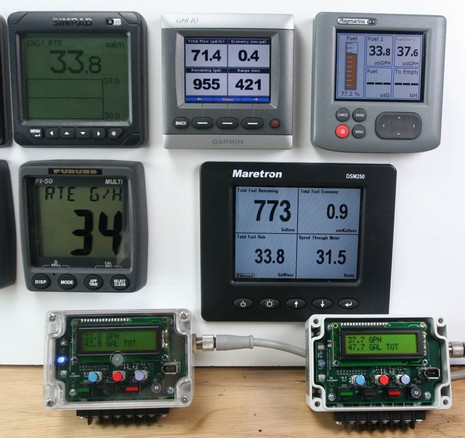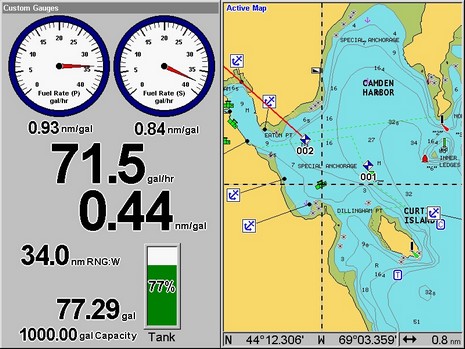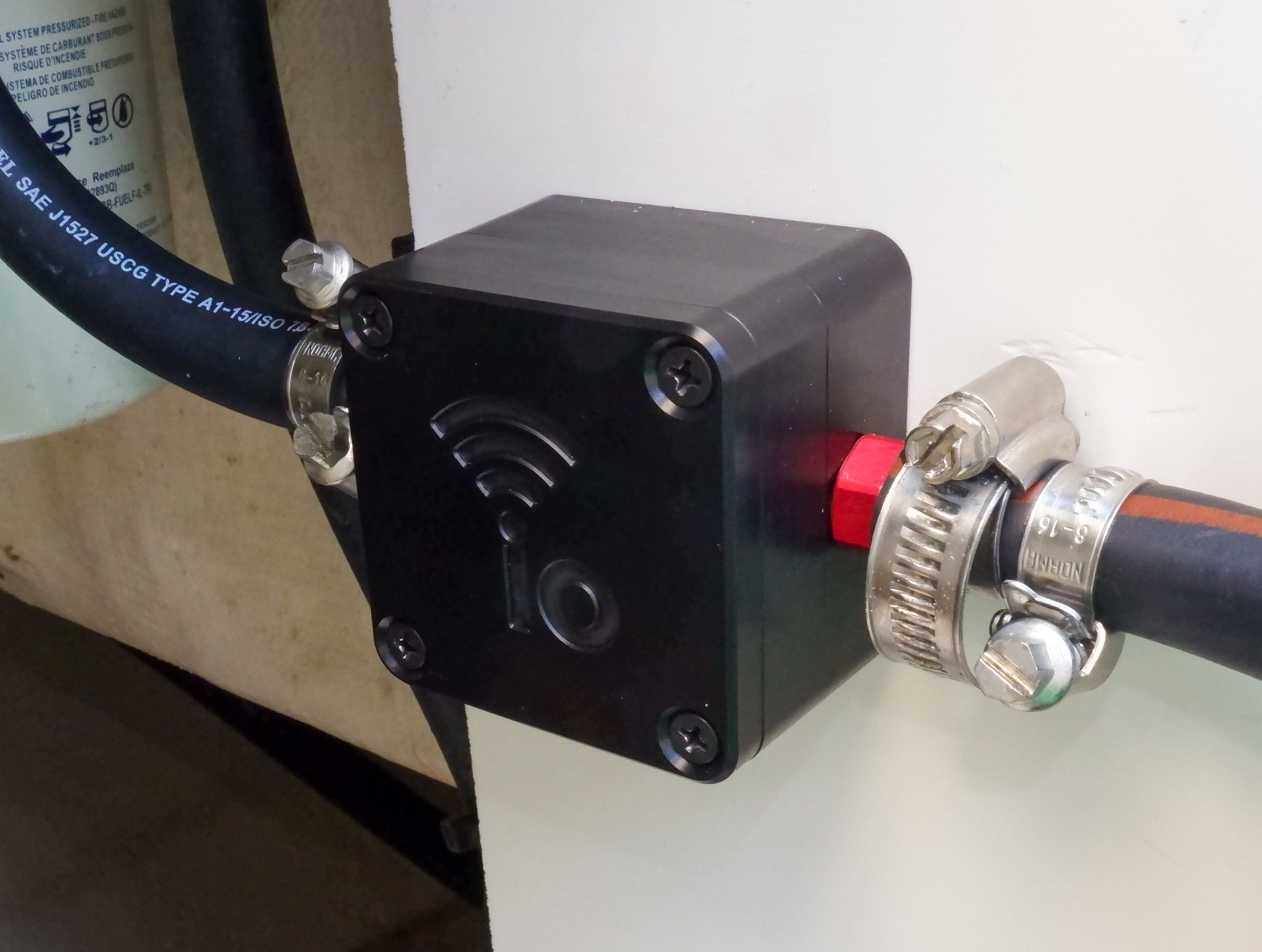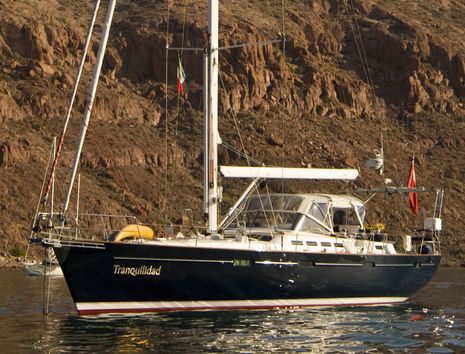Fuel management 2, FloScan

Consider this test a work in progress! (Bigger photo here.) Those are two FloNet N2K interface boxes that FloScan loaned me with built-in simulation of something like a big sportfishing boat blasting along on a plane. I can modify the simulated flow value somewhat using the calibration controls built into the box, which also has an “instance” switch so that the left one (instance 0) is set up as as the port engine and the right one (instance 1) represents the starboard engine. As noted on first sight, FloScan has designed this adaptor so that a special display is not needed to manage all its calibration and flow meter diagnostics; all you need is a display that understands what to do with a fuel flow message(s). Well, easier said than done, particularly when you throw twin flow values at those displays first, and read the manuals later!
The Garmin did pretty well, recognizing the two flow values and totaling them upper left and in the miles/gallon figure. However there’s a glitch in its “remaining fuel” figure (explained in Fuel Management, part 1); it’s only subtracting one flow value from the total gallons I’d programmed into it. I had to tell the Raymarine ST70 that it should look for two engines, for which it would give individual flow values, but not a total, and its miles/gallon “economy” just repeats flow, and gallons “to empty” didn’t seem to work (I may have missed something, or those functions may need tweaking). The Maretron at first only showed one engine’s flow and nm/gal, but I later figured out how to enable the other value and now it matches the Garmin. But note that Maretron’s definition of the “remaining fuel”, unlike Garmin’s, is the total tank capacity divided by its percentage level. I have it set to 1,000 gallons, 77.3% full. Note too that if you page to the Garmin’s fuel gauge, you’ll see 77% full, based on the Maretron tank PGN. Confused yet!
Then there’s the Furuno FI-50 Multi, which shows the flow rate of the “0” port engine. If there is a way to set it up for two engines, I haven’t found it yet. It also, like the Simrad, does not seem to do an nm/gal economy calculation, but it seems to be the only display that can show the “gallons used” PGN coming from the FloNet (though only one). The Simrad recognizes two engine flow rates (also RPMs and tank levels) as possible data, but I can’t get both of them to show at once on a screen. Conclusion, which is no doubt frustrating for FloScan: not one of these displays can yet show everything you might want for dual engine fuel management. Check out the Lowrance LCX screen below to see what I mean. I set up the “Custom Gauges” window to show each engine’s individual flow and nm/gal values, as well as their total (in a big, ouch-that-hurts-at-$5–gallon font). The only glitch on this screen is a user error. The Lowrance is seeing the 1,000 gallon tank capacity and tank level from the Maretron sender but using its own mis-programmed tank value of 100 gallons to calculate range and fuel remaining. Now, I’m going to take the holiday off, and hopefully burn a little real gasoline on the water…but in much smaller quantities.
PS Turns out that the Garmin’s remaining fuel total is correct; what fooled me and is not correct is the gallon totals simulated on the FloNets. I wasn’t tracking time when I took that photo above, but can tell you now that it represents about 40 minutes of simulated fuel burn, as shown on the GMI (45 gallons used), not the 80 minutes or so suggested by the FloNets. Sorry, Garmin, especially the engineers who tried unsuccessfully to duplicate a “problem” that wasn’t. I’m sure that real FloNets total flow correctly.














Ben, first of all thanks SO much for all your efforts at publishing such great content on Panbo. Truly appreciated by those of us who are trying to make sense of all this and apply it as we are underway. (currently sailing in Costa Rica)
I have a 50′ sailboat with an old (1986) single 6 cyl. Onan/Cummins turbo diesel that I’m trying to fix or refit a full set of fuel monitoring data. I installed a NavMan 3200 diesel sytem 2 years ago before leaving on my circumnavigation and about 9 months ago it started acting up which I traced to a non functioning return line sender. I took it all apart and cleaned it thoroughly, no damage or problems but still doesn’t work (LED on the bottom does not light up). The instrument still reads out, tach works, but of course the readings are all wrong because it isn’t taking into account the returned fuel. Here are my questions (finally!)
1. NavMan is no longer making these units (nor NorthStar) and I can’t seem to find any source for replacement parts to buy a replacement sender. Do you know of any sources I could try?
2. If I have to I will install a whole new system and so your recent 6 part series on fuel management has been most interesting and helpful. I’m thinking of buying one of the Floscan NMEA FloNET diesel 2K units however I need to use my Raymarine E120 and RayTech software to display the data and I can’t seem to get any straight answers as to which fuel parameters the E-120 will be able to understand and display? You seemed to have problems getting the E-120 to understand and display some of the output from the Floscan unit so I’m wondering if you have any update, information or insight into this. I don’t want to spend all this $$ for the Floscan unit if i won’t be able to see the data.
3. At this time all my NMEA equipment is using NMEA 0183 and I don’t have anything that is using N2K so I’m wondering what all I will need to install in order to connect the Floscan FloNET box and feed it into my E-120? I’m currently in Costa Rica and about to head offshore next month (mid Feb) for the South Pacific so I need to get everything I’m going to need equipment and parts wise before I head out to these very isolated spots. Do you have a list or some references that I can use to help make sure I buy everything I’m going to need to install my first N2K network? I will be making a trip to the USA at the end of the month so I can pick things up when I’m there and bring them back but I want to make sure I have EVERYTHING I need before I get back to CR.
4. Lastly, I was intrigued by your most recent posting on the Lowrance LMF-400 unit, especially for that price! But I believe this system only works for gas engines is that correct?
Sorry for such a long winded note and thanks in advance for any assistance and direction you can provide.
Wayne
Hi Wayne.
(1) Sorry, I don’t know anything about Navman parts, but maybe someone here will.
(2) At the moment the E120 only displays the NMEA 2000 fuel flow number. It does not yet do valuable calculations like miles per gallon, remaining gallons, range, etc. I’m pretty sure Raymarine is working on this and the an update is due out soon.
(3) An N2K network to support the Floscan Flonet would be quite simple: three tees for 12v power feed, Flonet, and E120, plus two terminators and enough N2K cabling for the two “drops” and backbone to get from Flonet to E120. You’d also need the Raymarine conversion drop cable to go from standard N2K to SeaTalk2. I’ll bet Floscan could put this all together for you.
(4) The Lowrance EP flow sensor is only for gas engines, but the LMF-400 can handle Flonet data fine, and might make sense, at least as a display to get you by until the E120 is updated. However you’ll also need N2K SOG or Speed through Water on the backbone to get MPG and I don’t think the E120 will bridge those over from 0183 or SeaTalk1. You’d also need Lowrance’s EP memory module to keep track of fuel used and hence calculate range. The Raymarine ST70 is another possibility, but it too needs a software update to do fuel flow right.
Thanks Ben! Not the best of news for me (re Raymarine’s lack of support) but the best and fastest response from you I could ask for. Thanks!
More information on ST70 fuel flow: apparently Raymarine takes the stand that the implementation is OK because it will display gal/mile (Economy) and other calculated data IF that data is sent to the ST70.
But the other gear I tried—Lowrance, Garmin, and Maretron—all did the calculations themselves (but apparently did not put the calculated data on the NMEA 2000 bus). Meanwhile FlowScan, Garmin, and Lowrance sensors only seem to send out the flow value (plus the Lowrance stores a fuel-used value).
I don’t know for sure if Raymarine is working to make the ST70 do fuel calculations, but there is a 2.2 software update for the instrument. However, it has to be dealer installed (using an E-Series).
Ben, I wonder if you have any update on the ST70 and the FloNet sensors? I am looking for alternatives to the E-series that I have interfaced to two FlowNets as the e-series can only display total fuel flow for both sensors. Should I look Garmin GMI or Maretron?
Sorry, Jon, I really haven’t stayed up on this. Have you done the lastest E-Series update, and confirmed that Raymarine did not improve the situation?
I returned the E120 I was borrowing but I still have the FloNet simulators and the ST70 in the lab. I have not updated the ST70, though, and am not sure I can without sending the unit in (which seems odd).
I think that either the Garmin or Maretron displays will handle dual fuel flow fine, Lowrance LMF too.
“This forum post concerns persistent RFI interference with my ICOM M802 SSB from the Floscan, FloNet N2K , and the inability of Floscan to duplicate or fix the problem. I am trying to locate others with the problem.”
I read with great interest the Panbo report on the Floscan, FloNet N2K fuel monitoring system that received outstanding reviews. As a result I purchased this system and installed it aboard a Tashiba 40 sailboat with a single 50 Hp diesel engine. After a full season of use we found that FloNet works very well at reading fuel consumption. It is extremely accurate and reassuring to know what my fuel state is at any given time.
However….., There is one problem. We also have an Icom M802, single sideband radio. We use the high frequency radio for winlink email and communicating on 14,300 Mhz as well as some marine frequencies. It seems the FloNet control box emits a massive, pulsating, radio interference across most SSB frequencies.
I tested for this by disconnecting each N2k transducer drop cable, one at a time, and listening to the SSB radio. The RFI stopped consistently when the FloNet Box was disconnected. No other N2K transducer produced RFI. I contacted Floscan and started a summer long exchange with Sales and Tech Support Departments. We investigated my particular installation in detail especially the grounding of all devices, relocating the control box and changing out the drop cable without success. Tech support had me return my control box for analysis with their in house licensed HAM radio person and claimed they could not reproduce the RFI. They graciously upgraded my firmware and shipped my original box back and then asked for it back so they could replace it with one “especially prepared for me”. The replacement box had exactly the same problem.
I have recorded the pulsating sound from the radio and emailed the file to the Tech Support manager who identifies it as the N2K signal on the network. Tech Support personnel have no explanation why this goes away when the FloNet box drop cable is disconnected. Floscan’s contention is they do not have a problem with RFI. They can not explain my RFI issue and say they spoke to other SSB radio users at the Fort Lauderdale Boat show (2010) who do not have this problem. Personally, I question this finding.
After some email enquiry’s I found another FloNet / Icom M802, SSB radio user who also has the same RFI problem. He has suggested the possibility that the LED on the FloNet box may be responsible. In the past, LED technology had a reputation for producing radio noise.
I’m interested in finding out how wide spread this RFI issue is with similar installations. Both Floscan’s Sales and Tech Support managers consider it a non-issue because, “few people use SSB radio anymore”. But, for those of us who still use High Frequency radio this is a serious concern. FloNet’s RFI may make our Single Sideband Radio’s unusable especially during an emergency.